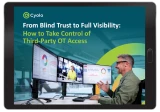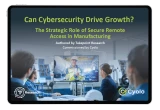Table of Contents
Can Legacy Technology and Modern Security Co-Exist?
Control room looking more like a manufacturing museum full of fossils?
Some of the legacy OT systems on your factory floor have barely evolved since the Jurassic period. But they still work, doing exactly what they were designed to do – day in and day out.
These systems were built long before anyone worried about multi-factor authentication (MFA), encryption, or native access controls. But in the intervening years, cyber threats – and therefore cybersecurity – have become a major concern for organizations running OT and cyber-physical systems (CPS).
And yet, replacing the legacy infrastructure that keeps operations running isn’t a viable option. Between the disruption, the cost, and the risk of breaking something mission-critical, ripping and replacing is the last thing anyone wants to do.
Now here’s the good news: Despite what some vendors may tell you, bringing your OT security up to date doesn’t require taking a forklift to your firewalls or risking an extinction-level infrastructure event that could stop your production line cold. With the right approach and solution, you can protect even your most prehistoric assets – all without replacing hardware, rewriting code, or changing any IP addresses.
Let’s dig into the better way to secure legacy OT systems in the modern age.
Why ‘Per-Machine Security’ Is Ancient History for Legacy OT
In the early days, OT security meant guarding each machine on its own. Patching locally. Managing logins one by one. Trusting each HMI or PLC to handle its own defenses – with all the muscle of a paper shield.
That might’ve passed for protection back in the era of isolation. But today?
You’re likely managing dozens – if not hundreds – of systems across multiple sites.
Many of them don’t support modern authentication, encryption, or other security best practices.
Manual patching is a logistical nightmare – and a great way to void warranties.
And legacy systems? They were never designed for remote access (or cybersecurity!) in the first place.
Updating each machine individually isn’t just time-consuming – in many cases, it’s practically impossible.
That’s why modern OT security doesn’t live inside the machine. It wraps around it like a protective shell, strengthening what’s already there without disrupting its environment.
Instead of patching every PLC or reconfiguring every sensor, you shift security from individual endpoints to the systems around them – enabling centralized, streamlined access controls, policy enforcement, and visibility before anyone touches a device.
The right secure remote access (SRA) tool will make it possible to:
Work with what you’ve got – even systems chugging along on software last patched in the dial-up era.
Avoid infrastructure overhauls – no re-IP-ing, no new hardware, no downtime.
Enforce the Zero Trust framework, including the principle of least privilege (PoLP) and continuous verification – without ripping out what’s already working.
And the best part? Your oldest, most critical systems stay right where they are, doing what they've been doing for years, while modern SRA technology makes sure only fully verified users and devices gain access.
Level Up Your Security Without the Stress
In manufacturing, as in other critical industries, even a so-called ‘quick fix’ can bring operations screeching to a halt.
That’s why SRA solutions that don’t mess with your infrastructure – or your uptime – are worth their weight in hardened steel. They give you protection that fits around your systems, instead of forcing you to gut and rebuild them. That means:
No downtime – You keep production rolling while security rolls out in the background.
No third-party blind spots – Whether it’s an OEM vendor or a SCADA specialist, you can give scoped, time-limited access without exposing your full network or relinquishing visibility.
No loss of control – You manage everything. You decide who gets in, what they see, and when they leave. No guesswork or gray areas.
No need to move to the cloud – Have some systems you prefer to keep on-prem or even entirely offline? No problem. There’s no reason to move to the cloud, change IP addresses, or overhaul your existing architecture just to enable secure remote access.
No compliance panic – Centralized access records, session logs, just-in-time controls, and policy enforcement help you tick all the NIS2 and NERC-CIP boxes.
A Real-World Case: 50 PLCs, Zero Cables Ripped Out
Let’s say your plant has 50 PLCs – all older than your summer intern. They’re stable, essential, and about as security-savvy as a stegosaurus.
You can’t patch them. You won’t risk updating them. So instead of merely crossing your fingers and hoping for the best, you cover them with an external shell of security:
Route all access through a secure gateway
Authenticate users via a central identity provider
Apply role-, time-, and task-based access controls
Supervise sessions in real-time and/or record sessions for compliance and incident response purposes
The result? Not a single PLC gets touched. Not a single wire is rerouted. But every connection is secure, monitored, and under your control.
Prepare Your Legacy OT for the Future with Cyolo
If your legacy systems still work, let them keep doing what they do best. Just don’t expect them to fend off modern cyber threats on their own.
OT security today isn’t about scrapping stable systems or forcing unwanted cloud migrations. Instead, it’s about maximizing what you already have and then surrounding your legacy OT in smart, scalable protection that will keep everything running smoothly and securely into the future.
And if you're looking for a tool that does exactly this, check out Cyolo PRO (Privileged Remote Operations), the access solution that connects third-party vendors and privileged employees to legacy OT and other critical assets in a way that’s secure, safe, and surprisingly simple.
Discover the Benefits of Cyolo PRO (Privileged Remote Operations)

Jennifer Tullman-Botzer
Author
Jennifer Tullman-Botzer has over a decade of experience in cybersecurity marketing and is as tired as you are of hackers-in-hoodies stock images. She joined Cyolo in 2021 and currently serves as Head of Content. Prior to Cyolo, Jennifer worked in a variety of marketing roles at IBM Security. She lives in Tel Aviv, Israel.

Subscribe to Our Newsletter







